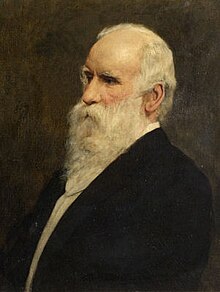Robert Stirling Newall
| Robert Stirling Newall | |
|---|---|
 |
|
| Born |
27 May 1812 Dundee, Scotland |
| Died | 21 April 1889 (aged 76) Gateshead, England |
| Nationality | Scottish |
| Known for | Submarine telegraph cable |
Robert Stirling Newall FRS FRAS (27 May 1812 – 21 April 1889) was a Scottish engineer and astronomer.
Born at Dundee on 27 May 1812, Newall began work in a local mercantile office before leaving for London, where, in the employment of Robert McCalmont, he worked on a series of experiments on the rapid generation of steam. He later spent two years promoting McCalmont's business interests in America.
In 1838, whilst L.D.B. Gordon was studying at the Freiburg School of Mines, Germany, he visited the mines at Clausthal, and met Wilhelm Albert. Impressed by what he saw, he wrote to Newall, urging him to "Invent a machine for making wire ropes". On receipt of Gordon's letter, Newall designed a wire rope machine, consisting of four strands and four wires to a strand. On Gordon's return to the UK in 1839, he formed a partnership with Newall and Charles Liddell, registering R.S. Newall and Company in Dundee. On 17 August 1840, Newall took out a patent for "certain improvements in wire rope and the machinery for making such rope."
R.S. Newall and Company established a factory in Gateshead, England, and commenced making wire ropes for "Mining, Railway, Ships' Rigging, and other purposes". From this point forward, Newall was instrumental in developing substantial improvements to submarine telegraph cables, devising a method involving the use of gutta percha surrounded by strong wires. The first successful cable, laid between Dover and Calais on 25 Sept. 1851, was turned out from his works, and he continued the manufacture on a large scale. In 1853 he invented the ‘brake-drum’ and cone for laying cables in deep seas. Owing to the scarcity of engineers competent to deal with the special difficulties of the work, Newall himself directed the submergence of many of his cables. Among these were the lines from Holyhead to Howth, Dover to Ostend, Malta to Corfu, besides several others in the Mediterranean, Suez to Aden, Aden to Kurrachee, Constantinople and Varna to Balaclava in 1855. Half of the first Atlantic cable was manufactured at his works. The last submarine line laid by him personally was that connecting Ringkjobing in Denmark with Newbiggen, Northumberland, in 1868.
...
Wikipedia
